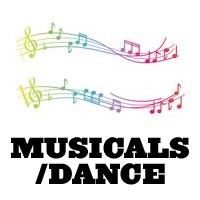Resurgence of Musicals:
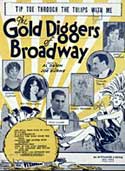 Warner
Bros. was the studio that produced the first talking picture in 1927,
the first movie operetta (The Desert Song (1929)), and the first color musicals. The first all-color (actually two-strip Technicolor)
sound musical was Warners' and director Alan Crosland's backstage musical On With the Show! (1929) - advertised as "the first 100%, Natural
Color, All-Singing Production" - with a plot similar to the later release, 42nd Street (1932/33). Director Edmund Goulding's big-budget musical Reaching for the Moon (1930), starring Douglas Fairbanks (in one of
his few sound pictures) and Bebe Daniels, was to be the first musical
to feature an all-Irving Berlin song score, but the studio eliminated all
of them except "When the Folks High-Up Do the Mean Low-Down", performed
by a young Bing Crosby, June MacCloy and Bebe Daniels. The studios began to fear that audiences were becoming exhausted by the number of songs in films. Warner
Bros. was the studio that produced the first talking picture in 1927,
the first movie operetta (The Desert Song (1929)), and the first color musicals. The first all-color (actually two-strip Technicolor)
sound musical was Warners' and director Alan Crosland's backstage musical On With the Show! (1929) - advertised as "the first 100%, Natural
Color, All-Singing Production" - with a plot similar to the later release, 42nd Street (1932/33). Director Edmund Goulding's big-budget musical Reaching for the Moon (1930), starring Douglas Fairbanks (in one of
his few sound pictures) and Bebe Daniels, was to be the first musical
to feature an all-Irving Berlin song score, but the studio eliminated all
of them except "When the Folks High-Up Do the Mean Low-Down", performed
by a young Bing Crosby, June MacCloy and Bebe Daniels. The studios began to fear that audiences were becoming exhausted by the number of songs in films.
The second full-length color
sound feature film ever made was Warners' ambitious and successful Technicolor musical The Gold Diggers of Broadway (1929) by director Roy Del Ruth. It featured a number of popular variety stage stars,
including talented dancers, singers, and comedians. It was famous for "Tip-Toe
Through the Tulips With Me" and "Painting the Clouds with Sunshine" by Nick Lucas, who also starred in the film. It was a remake of the silent,
non-musical comedy film about chorus girls, The Gold Diggers (1923) - and it was followed by Mervyn LeRoy's musical remake The Gold Diggers
of 1933 (1933). [In all, Warner Bros. made five Gold Diggers pictures, four of which were made in the 1930s. See more below.]
By 1932, however, Hollywood studios had glutted the public's
tired appetite and their overexposed song-and-dance epics (often sacrificing
plot and character development) went into a commercial decline, coinciding
with the height of the Great Depression. There were approximately 60 musicals in 1929, and over 80 in 1930, but by 1931, there were only 11. Audiences bypassed many of the musical
films that were being cranked out, and preferred to watch other genre creations,
such as the early gangster films: Public
Enemy (1931) and Little Caesar (1930),
the comedy film Min and Bill (1930),
or the Best Picture-winning western film Cimarron (1931). The novelty of sound had worn off and the popularity
of musicals suffered. For example, MGM's star-studded,
over-produced Hollywood Party (1934) with a host of writers and directors,
originally titled Hollywood Revue of 1933, was basically a disaster.
It had a mish-mashed plot, and starred such diverse actors as Laurel and Hardy,
Jimmy Durante, Lupe Velez, Polly Moran, Frances Williams, and The Three Stooges.
The Landmark Film: 42nd Street
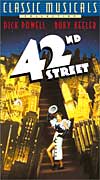 The
musical genre was really sparked, fortunately, when the Warners studio stole
director and dance choreographer Busby Berkeley away from United Artists.
(Earlier in the decade, Berkeley was hired by Sam Goldwyn as dance director
on four Eddie Cantor films (one each year), where he began to display his talents. In Whoopee! (1930), his debut film, Berkeley's first number was "Cowboys," partly crooned by 16 year-old Betty Grable, and the film also contained the first evidence of Berkeley's trademark "top shot" in "Song of the Setting Sun". In his next film Palmy Days (1931), Berkeley continued to demonstrate his visual ingenuity by having the Goldwyn Girls use placards to form a train at the end of the hit tune "My Honey Said Yes, Yes." And in The Kid From Spain (1932), Berkeley brought on criticism for his 'peeping tom' views of chorines' silhouettes behind a translucent screen. Finally, in Roman Scandals (1933), he exhibited further excesses, with his "No More Love" sequence in which long blonde-haired slave girls were chained nude to a wall.) The
musical genre was really sparked, fortunately, when the Warners studio stole
director and dance choreographer Busby Berkeley away from United Artists.
(Earlier in the decade, Berkeley was hired by Sam Goldwyn as dance director
on four Eddie Cantor films (one each year), where he began to display his talents. In Whoopee! (1930), his debut film, Berkeley's first number was "Cowboys," partly crooned by 16 year-old Betty Grable, and the film also contained the first evidence of Berkeley's trademark "top shot" in "Song of the Setting Sun". In his next film Palmy Days (1931), Berkeley continued to demonstrate his visual ingenuity by having the Goldwyn Girls use placards to form a train at the end of the hit tune "My Honey Said Yes, Yes." And in The Kid From Spain (1932), Berkeley brought on criticism for his 'peeping tom' views of chorines' silhouettes behind a translucent screen. Finally, in Roman Scandals (1933), he exhibited further excesses, with his "No More Love" sequence in which long blonde-haired slave girls were chained nude to a wall.)
The Warners
film that breathed new life into the musical form was Darryl Zanuck's executive
production of director Lloyd Bacon's 42nd Street (1932/33), another lively backstage drama that chronicled
the hard work of a manic Broadway director (Warner Baxter) behind the making
of a musical comedy - where life (whether as a director or chorus girl) depended
upon the success of the opening show. The Warner Bros.' 'putting on a show'
film (with two Oscar nominations for Best Picture and Best Sound, with no
wins) also featured two fresh new juvenile stars, Ruby Keeler (as a chorus
girl) and tenor Dick Powell, and it starred Ginger Rogers as veteran showgirl
Anytime Annie.
Berkeley made screen history in this milestone-grandfather
of spectacular musicals, with scores of chorus girls, large extravagant musical
'production numbers' and sumptuous art deco sets, surrealistic imagery, optical
effects, zoom lenses, escapist musical numbers, fast-paced timing and rhythmic
editing, and wise-cracking dialogue. Berkeley was aided by the penned tunes
of Harry Warren (and co-writer Al Dubin), who contributed "Shuffle Off
to Buffalo", "Young and Healthy", and the climactic title song
"42nd Street". [Songwriter/composer Warren also worked on Berkeley's
other 1933 films, and wrote some of the best-remembered musical songs ever
created.]
Busby Berkeley - Master Musical and Dance Choreographer:
It was the first real look at the imaginative choreography
of former Broadway dance director Busby Berkeley, a transplant from Broadway
musical-directing. He was the first to truly realize that a filmed musical
was totally different from a staged musical, with the camera becoming an integral
participant with the choreography. He was becoming known for his trademark
sensual, kaleidoscopic patterns of carefully-positioned, often scantily-clad
chorus girls with props photographed from above (his "top shot"), from swooping
cranes, from the trench below the stage, or from cameras placed on specially-designed
tracks to capture audacious camera movements. Abstract, shifting geometric
patterns, screen compositions, and props in his highly-stylized 'moving pictures'
included giant flowers, neon violins, and waterfalls.
In most of these unique films, emphasis was on large extravagant
(sometimes outlandish) musical numbers and sets. He used his chorus girls
not as individuals but as parts of large, attractive geometric patterns moving
with precise choreography. The images could be animated tiles in vast, ever-shifting
mosaics, fanciful geometric patterns or cascading designs. Often, he would
use his legendary cinematic "top view" shot to capture the kaleidoscopic
views. He dressed the girls up in preposterous costumes, sometimes as coins
or musical instruments, or the chorus girls would wear next to nothing but
wisps of gauze. He also introduced the 'chorine close-up' shot.
Berkeley produced many more distinctive musicals during the
Depression-afflicted 1930s for Warner Bros. In fact, Berkeley alone choreographed
three films for WB in 1933 (*). [Note: These three films all featured performers
Dick Powell, Ruby Keeler, Guy Kibbee, Lorena Layson, Renee Whitney and Pat
Wing. They also featured songs written by Al Dubin and Harry Warren, and conducted
by Leo F. Forbstein.] Each movie attempted to outdo the previous extravaganza
in exotic, erotic flamboyance (in chronological order):
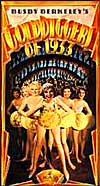 He
introduced spectacular musical numbers (often non-integrated into the narrative)
with stylized action, astonishing sets, and huge lavish dance numbers for
the Gold Digger series. Mervyn LeRoy's blockbuster Gold Diggers
of 1933 (1933) (a remake of the Gold Diggers of Broadway (1929) which itself was a remake of the silent film Gold Diggers (1923) about
chorus girls), was one of Berkeley's purest fantasies for the Depression Era.
It featured a young, coin-clad Ginger Rogers in the opening production number
leading a chorus line of showgirls garbed in more gold-coin costumes singing
"We're in the Money" (with one verse in Pig Latin). In another scene,
Berkeley undressed his pretty chorus girls entirely behind screens, backlighting
them so that the audience could see all they had to offer in silhouette. In
another romantic scene "The Shadow Waltz", neon-lighted violins
formed geometric designs on the screen with girls dressed all in white. The
film ended with the social commentary of the finale's downbeat number: "Remember
My Forgotten Man" accompanied by the singing of Joan Blondell. He
introduced spectacular musical numbers (often non-integrated into the narrative)
with stylized action, astonishing sets, and huge lavish dance numbers for
the Gold Digger series. Mervyn LeRoy's blockbuster Gold Diggers
of 1933 (1933) (a remake of the Gold Diggers of Broadway (1929) which itself was a remake of the silent film Gold Diggers (1923) about
chorus girls), was one of Berkeley's purest fantasies for the Depression Era.
It featured a young, coin-clad Ginger Rogers in the opening production number
leading a chorus line of showgirls garbed in more gold-coin costumes singing
"We're in the Money" (with one verse in Pig Latin). In another scene,
Berkeley undressed his pretty chorus girls entirely behind screens, backlighting
them so that the audience could see all they had to offer in silhouette. In
another romantic scene "The Shadow Waltz", neon-lighted violins
formed geometric designs on the screen with girls dressed all in white. The
film ended with the social commentary of the finale's downbeat number: "Remember
My Forgotten Man" accompanied by the singing of Joan Blondell.
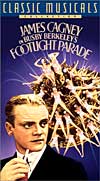 One
of Berkeley's greatest extravaganzas in the same year was another
Lloyd Bacon collaboration: Footlight
Parade (1933), in which Ruby Keeler and Joan
Blondell co-starred with lively yet crazed Broadway musical producer
Chester Kent (James Cagney). The film had three classic musical production
numbers including "Honeymoon Hotel" about a hotel full of
newlywed couples, "By a Waterfall," and "Shanghai Lil." The
most incredible and showy of all the sequences of musical fantasy in
Berkeley's films was the 10-minute production number "By a Waterfall".
It featured an elaborate aquacade
of 100 bathing-suited girls, performing kaleidoscopic patterns in the
water, and climaxing in a huge, revolving human
fountain (resembling a wedding cake) that was reflected in a pool. One
of Berkeley's greatest extravaganzas in the same year was another
Lloyd Bacon collaboration: Footlight
Parade (1933), in which Ruby Keeler and Joan
Blondell co-starred with lively yet crazed Broadway musical producer
Chester Kent (James Cagney). The film had three classic musical production
numbers including "Honeymoon Hotel" about a hotel full of
newlywed couples, "By a Waterfall," and "Shanghai Lil." The
most incredible and showy of all the sequences of musical fantasy in
Berkeley's films was the 10-minute production number "By a Waterfall".
It featured an elaborate aquacade
of 100 bathing-suited girls, performing kaleidoscopic patterns in the
water, and climaxing in a huge, revolving human
fountain (resembling a wedding cake) that was reflected in a pool.
Dames (1934) included Berkeley's inventive, staged
choreography in a title production number (Harry Warren's and Al Dubin's love song "I Only Have Eyes For You")
in which gigantic, precision-fit jigsaw puzzle pieces on the backs of dancing
chorus girls came together to form a large picture of the face of Ruby Keeler.
The 'backstage musical' film also featured showgirl Mabel Anderson (Joan Blondell) solo-singing "The
Girl at the Ironing Board".
The visually-stunning Gold Diggers of 1935 (1935),
not only production-designed but directed by Berkeley, featured one of the
finest examples of Berkeley's inventiveness. He traced the experiences of
a chorus girl through a day and night, culminating with her death fall from
a Manhattan balcony. In another sequence titled "The Words Are In My
Heart", pretty chorus girls playing long rows of two-dozen separate white
pianos were merged together into one huge piano. He accomplished this spectacular
feat by having his stagehands invisibly dressed in black while they wheeled
the pianos around on stage. The film climaxed with Berkeley's large-scale
dancing number "Lullaby of Broadway". The inventive, show-stopping, tap-dancing climactic finale - a film within a film - of a day in the life
of the Great White Way of New York, started with an opening shot (in a dark
frame) of a lit, approaching, disembodied, singing, and upturned face
(singer Wini Shaw's face) followed by a famous dissolve (into an aerial
shot of Manhattan) - and then told a mordant and cautionary tale
of life (and death by falling from a skyscraper balcony) in the hedonistic
night-time city.
The era of extravagant Gold Diggers/Berkeley numbers
began its decline shortly after the mid-30s, due to production cuts and enforcement
of the Production code that forbade some of Berkeley's sublimated sexual images.
The famed director/choreographer was restricted to only two production numbers
in Lloyd Bacon's Gold Diggers of 1937 (1936), featuring the ten-minute
final musical number "All's Fair in Love and War", nominated for
Best Dance Direction. It featured Joan Blondell leading a chorus of 104 women
dressed in white military uniforms (against a shiny black floor) as they tapped
their way through a series of military formations and flag-wavings with Berkeley's
trademarked geometric patterns. By the time the last Gold Diggers film
was released, Gold Diggers in Paris (1938), Rudy Vallee had replaced
Dick Powell (who had starred in the previous three Gold Digger films),
and the budgets for Berkeley's numbers were drastically cut and scaled down.
MGM's 'Singing Sweethearts': Jeanette MacDonald and Nelson
Eddy
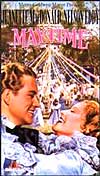 MGM
studios also contributed to the resurgence of musicals in the 1930s, filming
a number of "singing sweethearts" or "America's sweethearts" films
teaming baritone Nelson Eddy and Jeanette MacDonald singing romantic duets
in remade operettas with bittersweet romantic themes. After Jeanette starred
in Paramount's film version of the operetta The Vagabond King (1930) as heroine Katherine with co-star Dennis King as the roguish poet Francois
Villon, and in the Ernst Lubitsch/Paramount production of One Hour With
You (1932), she appeared in Rouben Mamoulian's/Paramount's musical fairytale Love Me Tonight (1932) (with a star-making role for Myrna Loy) featuring
a Rodgers and Hart score. She also starred in MGM's The Merry Widow (1934) with Maurice Chevalier, and then was successfully and profitably paired with
Nelson Eddy. They starred in eight films together from 1935 to 1942: MGM
studios also contributed to the resurgence of musicals in the 1930s, filming
a number of "singing sweethearts" or "America's sweethearts" films
teaming baritone Nelson Eddy and Jeanette MacDonald singing romantic duets
in remade operettas with bittersweet romantic themes. After Jeanette starred
in Paramount's film version of the operetta The Vagabond King (1930) as heroine Katherine with co-star Dennis King as the roguish poet Francois
Villon, and in the Ernst Lubitsch/Paramount production of One Hour With
You (1932), she appeared in Rouben Mamoulian's/Paramount's musical fairytale Love Me Tonight (1932) (with a star-making role for Myrna Loy) featuring
a Rodgers and Hart score. She also starred in MGM's The Merry Widow (1934) with Maurice Chevalier, and then was successfully and profitably paired with
Nelson Eddy. They starred in eight films together from 1935 to 1942:
- Naughty Marietta (1935)
- Rose-Marie (1936) (with
the song "Indian Love Call" known for its phrase, "When
I'm calling you-Oo-Oo-Oo")
- Maytime (1937)
- The Girl of the Golden West (1938)
- Sweethearts (1938)
- Bitter Sweet (1940)
- New Moon (1940)
- I Married an Angel (1942)
Nelson Eddy's debut was in the revised operetta Naughty
Marietta (1935). Their best remembered (and most commercially successful
film together) was Rose Marie (1936). Maytime
(1937), a 1937 box-office champion was a beautiful, bittersweet love
story featuring the famed duo reprising the oft-repeated "Will You Remember?"
Their film Sweethearts (1938), MGM's first Technicolor feature,
demonstrated the effectiveness of color - its color cinematography won an
Oscar.
MGM Dancing Star Eleanor Powell:
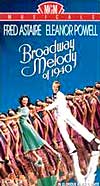 Another
of the musical stars on the MGM studio lot during the 1930s was former Broadway
performer and glamorous tap dancer Eleanor Powell, who starred in a number
of popular musical films. Over her long career, she danced with the likes
of Fred Astaire. The best of her films were the following (notice that they
included three Broadway Melody films): Another
of the musical stars on the MGM studio lot during the 1930s was former Broadway
performer and glamorous tap dancer Eleanor Powell, who starred in a number
of popular musical films. Over her long career, she danced with the likes
of Fred Astaire. The best of her films were the following (notice that they
included three Broadway Melody films):
- The Broadway Melody of 1936 (1935) - a bit role,
but Powell's first association with MGM; Powell played opposite Robert Taylor,
and supporting cast members Jack Benny and June Knight; this film, the best
in the series, was one of the few sequels to be nominated for Best Picture
- Born to Dance (1936) featuring Powell in her first
lead film role tap-dancing on board an Art-Deco battleship
- the expensive, over-produced Rosalie (1937) featuring
a Cole Porter score and co-star Nelson Eddy
- The Broadway Melody of 1938 (1937), a film in which
Powell's dance solos were overshadowed by a young Judy Garland (her original
name was Frances Gumm, in her first feature film appearance) singing and
dancing with Buddy Ebsen and singing the classic "You Made Me Love You"
to a photograph of Clark Gable ("Dear Mr. Gable")
- Honolulu (1939), in which Powell performs a hula-style
tap dance, and also a stair-tapping tribute - in blackface - to Bill "Bojangles"
Robinson
- The Broadway Melody of 1940 (1940), one of Powell's
best, with a six-minute, film-ending tap-dance with Fred Astaire to Cole Porter's
tune "Begin the Beguine"
- Lady Be Good (1941), with George Gershwin songs
- Ship Ahoy (1942)
- Sensations of 1945 (1944) - Powell's final starring
film
1936's Best-Picture Winning Biopic Musical:
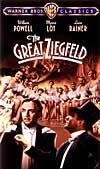 Another
lavish musical from MGM during the 1930s was The Great Ziegfeld (1936),
the second Oscar-winning musical. It was the epic musical biography of impresario/showman
Florenz Ziegfeld (starring William Powell, Luise Rainer, and Myrna Loy), that
also featured actual Follies stars as themselves, such as Fannie Brice, Will
Rogers, and Eddie Cantor. The three-hour, over-rated Best Picture Academy
Award winning film, defeated other worthy Best Picture nominees A Tale
of Two Cities (1936) and Dodsworth (1936) in a year in which Astaire-Rogers' Swing Time (1936) was not nominated for the
top award. Gargantuan numbers and songs included: "Won't You Come Play With
Me?," "It's Delightful to be Married," "If You Knew Susie," "Shine on Harvest
Moon," "A Pretty Girl is Like a Melody," "You Gotta Pull Strings," "She's
a Follies Girl," "You," and "You Never Looked So Beautiful." Luise Rainer
also won the first Oscar statuette awarded to an actress in a musical,
for her role as Ziegfeld's stage star Anna Held - for a memorable telephone
scene. Another
lavish musical from MGM during the 1930s was The Great Ziegfeld (1936),
the second Oscar-winning musical. It was the epic musical biography of impresario/showman
Florenz Ziegfeld (starring William Powell, Luise Rainer, and Myrna Loy), that
also featured actual Follies stars as themselves, such as Fannie Brice, Will
Rogers, and Eddie Cantor. The three-hour, over-rated Best Picture Academy
Award winning film, defeated other worthy Best Picture nominees A Tale
of Two Cities (1936) and Dodsworth (1936) in a year in which Astaire-Rogers' Swing Time (1936) was not nominated for the
top award. Gargantuan numbers and songs included: "Won't You Come Play With
Me?," "It's Delightful to be Married," "If You Knew Susie," "Shine on Harvest
Moon," "A Pretty Girl is Like a Melody," "You Gotta Pull Strings," "She's
a Follies Girl," "You," and "You Never Looked So Beautiful." Luise Rainer
also won the first Oscar statuette awarded to an actress in a musical,
for her role as Ziegfeld's stage star Anna Held - for a memorable telephone
scene.
Goldwyn's Musicals with Eddie Cantor:
Broadway comedian Eddie Cantor starred in six musical comedies
independently produced by Samuel Goldwyn in the 30s, including:
- Whoopee! (1930) - from Flo Ziegfeld's Broadway spectacular,
with the hit songs: "My Baby Just Cares For Me" and "Makin'
Whoopee"
- Palmy Days (1931)
- The Kid From Spain (1932)
- Roman Scandals (1933) - probably the best of the
group
- Kid Millions (1934)
- Strike Me Pink (1936)
Shirley Temple at 20th Century Fox:
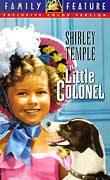 Besides
MGM, other studios had their own musical attractions, and merchandising 'cash
cows.' One of the biggest money-making, musical super-stars of the mid-1930s
was Twentieth Century Fox's talented, naturally-acting, charming child attraction
Shirley Temple. The diminutive, curly-topped sensation earned a special Oscar
in 1934 "in grateful recognition to her outstanding contribution to screen
entertainment." Although her films went into decline by the late 30s
as she got older, she achieved legendary film status in such films as: Besides
MGM, other studios had their own musical attractions, and merchandising 'cash
cows.' One of the biggest money-making, musical super-stars of the mid-1930s
was Twentieth Century Fox's talented, naturally-acting, charming child attraction
Shirley Temple. The diminutive, curly-topped sensation earned a special Oscar
in 1934 "in grateful recognition to her outstanding contribution to screen
entertainment." Although her films went into decline by the late 30s
as she got older, she achieved legendary film status in such films as:
- Baby Take A Bow (1934) - her first starring vehicle
- Bright Eyes (1934) - one of Shirley's best, with
her classic rendition of "On the Good Ship Lollipop"
- Little Miss Marker (1934)
- Curly Top (1935) - with Shirley as a resident of
an orphanage, and noted for her phrase: "Oh, my goo'ness!" - [this
phrase was referenced in the latter film Annie (1980)]
- The Little Colonel (1935) with her famous staircase
dance sequence with 56 year-old vaudevillian and musical stage star Bill
"Bojangles" Robinson; has a short Technicolor finale
- The Littlest Rebel (1935) - a Civil War era film,
the finale includes a 'challenge dance' against Bill Robinson
- Captain January (1936) including the delightful
song/dance number "At The Codfish Ball" with Buddy Ebsen
- Dimples (1936) - famous for Shirley's convincing
re-enactment of Little Eva's death scene in Uncle Tom's Cabin
- Poor Little Rich Girl (1936) - a remake of Mary
Pickford's 1917 film, co-starring Alice Faye
- Stowaway (1936) - as a character named Ching-Ching,
orphaned and stranded in Shanghai, China who stowaways on a ship bound for
San Francisco; known for Shirley's frequent spouting of wise 'Charlie Chan'
sayings, and her wonderful rendition of "You've got to S-M-I-L-E, To
be H-A-Double-P-Y"
- Heidi (1937) - includes a dream sequence set in
Holland with the singing of "In My Little Wooden Shoes"
- Wee Willie Winkie (1937) - directed by John Ford
and set in India
- Rebecca of Sunnybrook Farm (1938) with 10 year-old
Shirley performing a medley of many of her earlier hit songs, "On the
Good Ship Lollipop," "When I'm With You," and more
- Little Miss Broadway (1938)
- The Little Princess (1939) - her first Technicolor
feature film
Alice Fay and Betty Grable at 20th Century Fox:
For adult audiences, Fox's singer/dancer and musical performer
Alice Faye starred in such hits as:
- Sing, Baby, Sing (1936)
- You're a Sweetheart (1937) - Faye's only film for
Universal
- On the Avenue (1937) featuring Irving Berlin songs
- In Old Chicago (1938)
- Alexander's Ragtime Band (1938), a large-scale Irving
Berlin backstage musical with Don Ameche, Tyrone Power and young Ethel Merman
- director Henry King's Best Picture-nominated film was the first all-star
epic musical to feature classic Irving Berlin songs (28 songs including
"Heat Wave", "Now It Can Be Told" and Jack Haley's rendition
of "Oh How I Hate To Get Up In the Morning," among others) and
set the pattern for musicals into the 1940s; the film won the Best Score
Oscar for Alfred Newman's musical direction
- Rose of Washington Square (1939), with song classics
"California Here I Come," "Toot Toot Tootsie Goodbye,"
"I'm Just Wild About Harry," and "My Man"
- Tin Pan Alley (1940), an enjoyable costume picture starring
Alice Faye and Betty Grable as a pair of singing sisters, won the Best Score
Academy Award
- Hello Frisco, Hello (1943) - starring Faye (singing
"You'll Never Know") and co-star John Payne
- The Gang's All Here (1943) - this was Faye's final
starring role in a musical, director Busby Berkeley's only film for Fox,
and the one noted for Carmen Miranda's fruit-laden hat and the song "The
Lady in the Tutti-Frutti Hat"
 After
Alice Faye, Twentieth Century Fox found a successor in the person of blonde bombshell Betty
Grable for much of the 40s decade and into the mid-50s. They capitalized on
her popular and shapely "million dollar legs" made famous in WWII pin-ups
showing her mostly in a rear-view image. Grable appeared in many nonsensical,
Technicolor extravaganzas including the musical comedy Moon Over Miami
(1941) with Carol Landis and supporting player Charlotte Greenwood, Footlight
Serenade (1942) with Victor Mature, Springtime in the Rockies (1942) with supporting Brazilian player Carmen Miranda, Coney Island (1943), Pin-Up Girl (1944) - a title that capitalized on her earlier fame,
and the hit film The Dolly Sisters (1945). Fox's Technicolored State
Fair (1945), with Jeanne Crain and Dana Andrews, was the only Rodgers
& Hammerstein musical written directly for the screen. Its tune, "It
Might As Well Be Spring" won the Oscar for Best Song. After
Alice Faye, Twentieth Century Fox found a successor in the person of blonde bombshell Betty
Grable for much of the 40s decade and into the mid-50s. They capitalized on
her popular and shapely "million dollar legs" made famous in WWII pin-ups
showing her mostly in a rear-view image. Grable appeared in many nonsensical,
Technicolor extravaganzas including the musical comedy Moon Over Miami
(1941) with Carol Landis and supporting player Charlotte Greenwood, Footlight
Serenade (1942) with Victor Mature, Springtime in the Rockies (1942) with supporting Brazilian player Carmen Miranda, Coney Island (1943), Pin-Up Girl (1944) - a title that capitalized on her earlier fame,
and the hit film The Dolly Sisters (1945). Fox's Technicolored State
Fair (1945), with Jeanne Crain and Dana Andrews, was the only Rodgers
& Hammerstein musical written directly for the screen. Its tune, "It
Might As Well Be Spring" won the Oscar for Best Song.
June Allyson:
MGM's 'girl-next-door' star was June Allyson who made her
film debut in Best Foot Forward (1943). Later she starred in MGM's
war-time musical revue Two Girls and a Sailor (1944), and in three
roles she portrayed James Stewart's wife: in The Stratton Story (1949),
in Universal's Big Band musical biography The Glenn Miller Story (1954) (considered her best role), and in Strategic Air Command (1955). |
